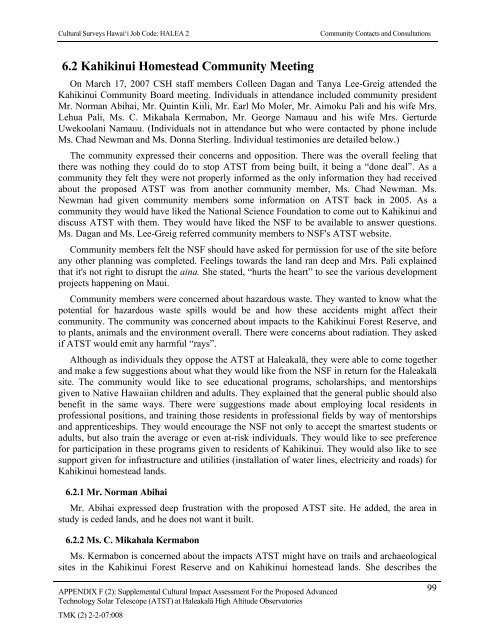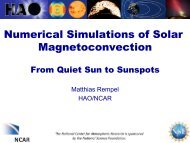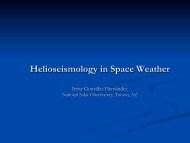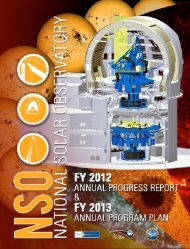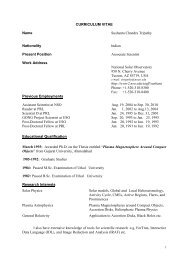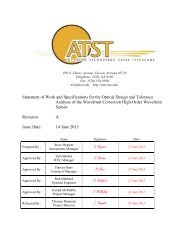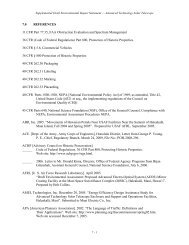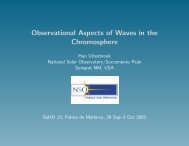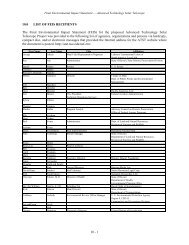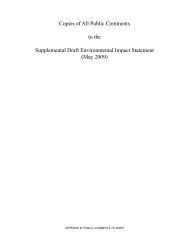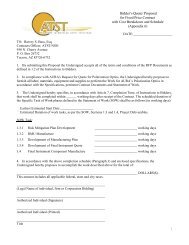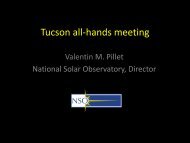F2 - ATST
F2 - ATST
F2 - ATST
Create successful ePaper yourself
Turn your PDF publications into a flip-book with our unique Google optimized e-Paper software.
Cultural Surveys Hawai‘i Job Code: HALEA 2Community Contacts and Consultations6.2 Kahikinui Homestead Community MeetingOn March 17, 2007 CSH staff members Colleen Dagan and Tanya Lee-Greig attended theKahikinui Community Board meeting. Individuals in attendance included community presidentMr. Norman Abihai, Mr. Quintin Kiili, Mr. Earl Mo Moler, Mr. Aimoku Pali and his wife Mrs.Lehua Pali, Ms. C. Mikahala Kermabon, Mr. George Namauu and his wife Mrs. GerturdeUwekoolani Namauu. (Individuals not in attendance but who were contacted by phone includeMs. Chad Newman and Ms. Donna Sterling. Individual testimonies are detailed below.)The community expressed their concerns and opposition. There was the overall feeling thatthere was nothing they could do to stop <strong>ATST</strong> from being built, it being a “done deal”. As acommunity they felt they were not properly informed as the only information they had receivedabout the proposed <strong>ATST</strong> was from another community member, Ms. Chad Newman. Ms.Newman had given community members some information on <strong>ATST</strong> back in 2005. As acommunity they would have liked the National Science Foundation to come out to Kahikinui anddiscuss <strong>ATST</strong> with them. They would have liked the NSF to be available to answer questions.Ms. Dagan and Ms. Lee-Greig referred community members to NSF's <strong>ATST</strong> website.Community members felt the NSF should have asked for permission for use of the site beforeany other planning was completed. Feelings towards the land ran deep and Mrs. Pali explainedthat it's not right to disrupt the aina. She stated, “hurts the heart” to see the various developmentprojects happening on Maui.Community members were concerned about hazardous waste. They wanted to know what thepotential for hazardous waste spills would be and how these accidents might affect theircommunity. The community was concerned about impacts to the Kahikinui Forest Reserve, andto plants, animals and the environment overall. There were concerns about radiation. They askedif <strong>ATST</strong> would emit any harmful “rays”.Although as individuals they oppose the <strong>ATST</strong> at Haleakalā, they were able to come togetherand make a few suggestions about what they would like from the NSF in return for the Haleakalāsite. The community would like to see educational programs, scholarships, and mentorshipsgiven to Native Hawaiian children and adults. They explained that the general public should alsobenefit in the same ways. There were suggestions made about employing local residents inprofessional positions, and training those residents in professional fields by way of mentorshipsand apprenticeships. They would encourage the NSF not only to accept the smartest students oradults, but also train the average or even at-risk individuals. They would like to see preferencefor participation in these programs given to residents of Kahikinui. They would also like to seesupport given for infrastructure and utilities (installation of water lines, electricity and roads) forKahikinui homestead lands.6.2.1 Mr. Norman AbihaiMr. Abihai expressed deep frustration with the proposed <strong>ATST</strong> site. He added, the area instudy is ceded lands, and he does not want it built.6.2.2 Ms. C. Mikahala KermabonMs. Kermabon is concerned about the impacts <strong>ATST</strong> might have on trails and archaeologicalsites in the Kahikinui Forest Reserve and on Kahikinui homestead lands. She describes theAPPENDIX F (2): Supplemental Cultural Impact Assessment For the Proposed AdvancedTechnology Solar Telescope (<strong>ATST</strong>) at Haleakalā High Altitude ObservatoriesTMK (2) 2-2-07:00899


